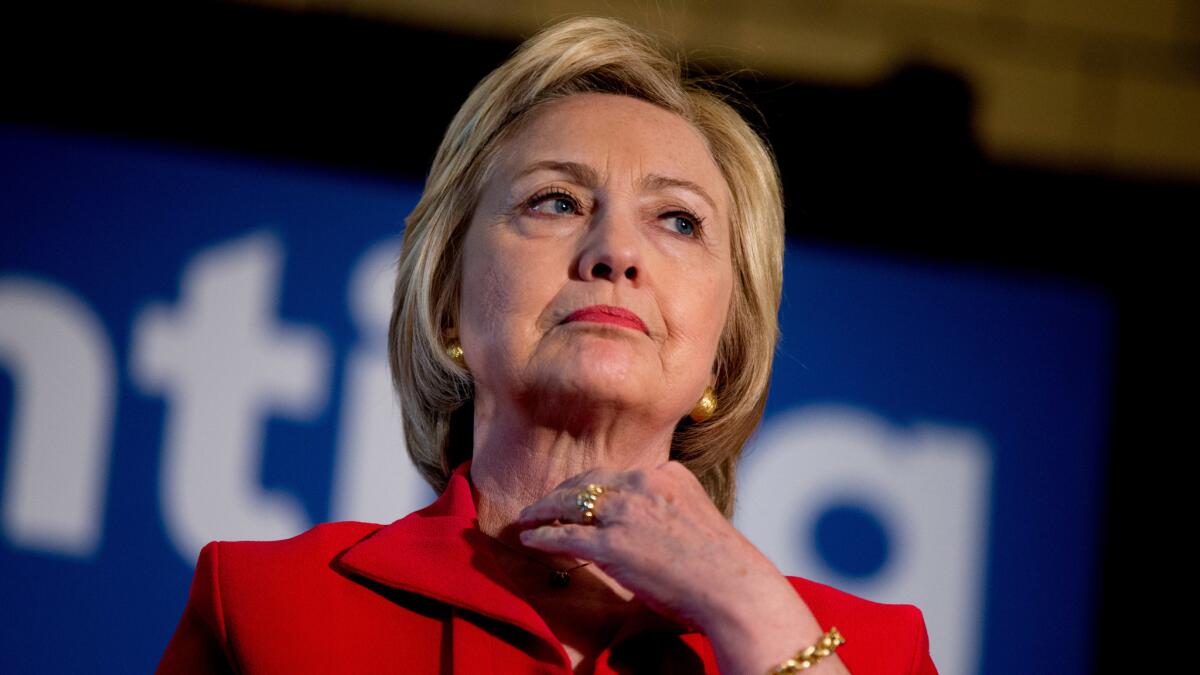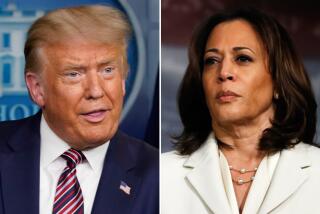Column: Polls show Hillary Clinton and Donald Trump in a virtual tie. Should Democrats be worried?

Democratic presidential candidate Hillary Clinton waits to speak at an event in Bowling Green, Ky. in May.
- Share via
Democrats hoped this presidential election would be a cakewalk. In their eyes, the presumptive Republican nominee, Donald Trump, spent most of the spring alienating big chunks of the electorate, beginning with women. Meanwhile, the presumptive Democratic candidate, Hillary Clinton, has run a careful, well-funded, well-honed campaign. What could go wrong?
And yet, in a spate of reputable surveys Trump has suddenly erased the advantage Clinton had held all year. The average of major polls compiled by the website RealClearPolitics shows the two candidates tied with 43% each. In at least three polls, Trump has even pulled ahead – although by a slim margin. That’s been enough to send some Democrats into a swivet. But they shouldn’t panic.
First of all, polls in May don’t have much predictive value about an election that’s more than five months away.
Four years ago, in May 2012, Mitt Romney was tied with President Obama in the RealClearPolitics average, just as Trump and Clinton are tied today. In November, Romney lost by four percentage points.
In May 2008, John McCain was only a little behind Obama, according to the same index. In November, McCain lost by seven percentage points.
Or go all the way back to May 1980, when then-President Carter held a forbidding 12-point lead over Republican challenger Ronald Reagan in one survey. In November, Reagan won by a wide margin
There’s one big reason Trump is doing better than expected in the polls: Republican voters have rallied behind him faster than some analysts expected.
Many GOP leaders, beginning with Romney, House Speaker Paul D. Ryan and presidential runner-up Ted Cruz, have refused to endorse the apparent nominee – but that hasn’t stopped rank-and-file conservatives from closing ranks. In an NBC News-Wall Street Journal poll released this week, Trump’s support among Republicans in a head-to-head contest with Clinton jumped to 86%, up from 72% a month earlier.
Democrats, by contrast, are still divided between Clinton and Bernie Sanders. In the same poll, only about two-thirds of Sanders voters were willing to say they would vote for Clinton in November if she wins the nomination. Her support among Democrats has actually declined slightly, from 87% a month ago to 84% now, and so has her backing among independents.
That depresses Clinton’s overall number and makes her look weak – but it’s probably only a temporary weakness.
If history is any guide, almost all of those Sanders voters will move into Clinton’s column once she is actually the nominee – especially if Sanders keeps his promise to campaign for Clinton (or against Trump) in the fall.
“Sanders people say they won’t vote for her now, but they’ll get over it,” predicts William Schneider, a pollster and political scientist at Virginia’s George Mason University who has been analyzing presidential campaigns since 1976.
One more factor that should help Clinton: Obama has regained some of his lost popularity. In recent polls, the president’s job approval has reached 51%, its highest level since his second inauguration in 2013. That means Obama would be an asset to the Democratic nominee in the fall.
All that said, Clinton still faces serious challenges.
After six years of political gridlock, many voters are yearning for change in Washington, and that should help Trump.
After six years of political gridlock, many voters are yearning for change in Washington, and that should help Trump. In the NBC-Journal poll, 53% of voters said they would prefer a president who would bring major changes to Washington, “even if it is not possible to predict what the changes may be.” Only 43% said they’d prefer “a steady approach [with] fewer changes.”
“She has become the candidate of the status quo, and that’s not a happy place to be,” Schneider said of Clinton.
Clinton also has a problem with independent and moderate voters (two different but not always distinct categories). Several polls have shown her losing to Trump among independents. Among moderates, who ought to be a natural constituency for her, the NBC-Journal poll found her running roughly even with the Republican.
“The more she pulls to the left because of pressure from Sanders, the less appealing she is for independents in the center,” said David Winston, a former advisor to Newt Gingrich. “She has to find a way to appeal to Sanders supporters and also build a majority coalition. That’s not an easy task.”
Guy Cecil, who runs the biggest super PAC supporting Clinton, disagreed. “Obama lost independents in 2012, but he still won the election,” he noted.
Finally, a problem both candidates face: They’re the least-popular candidates ever to win their parties’ nominations. Both are viewed unfavorably by a majority of voters – the first time that has happened in the history of modern polling.
Democrats and Republicans alike appear driven this year by what political scientists call “negative partisanship”: They may not like their standard-bearer much, but they loathe the other side’s candidate with a passion.
So far, both candidates appear to accept that glum sentence. Both Clinton and Trump are running as the lesser of two evils.
The polls that show Trump’s support rising and Clinton’s slipping are neither mirages nor predictions. They’re snapshots of a moving target. It’s too early to panic. But it’s never too early to worry.
Twitter: @DoyleMcManus
MORE
State Department audit faults Hillary Clinton on email security
Trump’s backers and critics square off in Anaheim; 1 protester ejected as police urge calm
Hillary Clinton is ready to take on Donald Trump. Bernie Sanders supporters say not so fast.
Follow the Opinion section on Twitter @latimesopinionand Facebook
More to Read
A cure for the common opinion
Get thought-provoking perspectives with our weekly newsletter.
You may occasionally receive promotional content from the Los Angeles Times.











